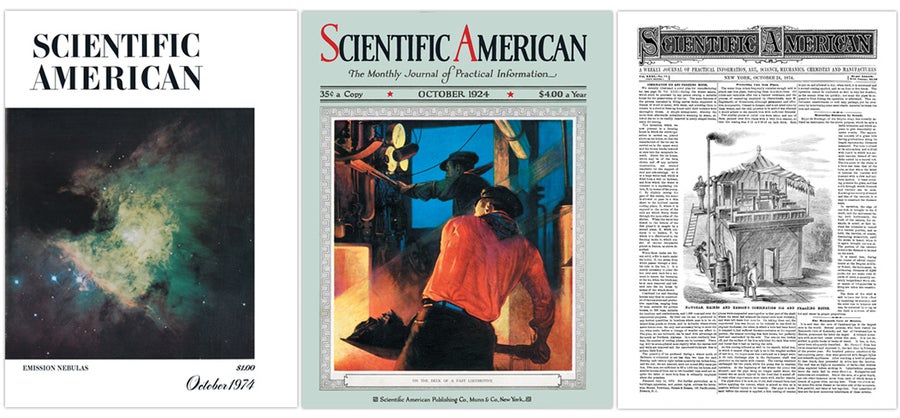October 2024: Science History from 50, 100 and 150 Years Ago

September 17, 2024
3 min read
October 2024: Science History from 50, 100 and 150 Years Ago
Best baseball batting order; mummies demystified
1924, Safer Traffic: “Idealistic sketch shows how the proper delineation of traffic lanes that bring all intersecting courses together at right angles will iron out the confusion of a busy corner. [And yet] the flashing beacon is vastly superior to mere marks on the pavement or signs at the curb.”
Scientific American, Vol. 131, No. 4; October 1924
1974
Best Baseball Batting Order
“Managers and baseball strategists give much thought to the batting order, following such precepts as putting a good runner first and a big hitter in the ‘cleanup,’ or fourth, spot. Does it make any difference? R. Allan Freeze of the University of British Columbia, writing in Operations Research, says ‘the effect of using the best batting order rather than the worst is less than three extra wins per 162-game season.’ Freeze conducted a computer simulation of some 200,000 baseball games, with teams in the traditional lineup, a second lineup of hitters in descending order of productivity, and a third lineup in ascending order.”
On supporting science journalism
If you’re enjoying this article, consider supporting our award-winning journalism by subscribing. By purchasing a subscription you are helping to ensure the future of impactful stories about the discoveries and ideas shaping our world today.
1924
Life and Limb for Air Mail
“We pay tribute to the people of the Post Office Transcontinental Air Mail Service, the greatest single step ever taken to make commercial aviation a practical day-and-night reality. Very much to the point is the following quotation from a talk by Captain Hyde-Pearson, a veteran of the World War, shortly before he was killed in the air mail service: ‘We risk our necks; we give our lives; we perfect a service for the benefit of the world at large.’ While you sit in the safe shelter of your office or sleep in the secure comfort of your bed, these boys by day and by night may be sweeping through rain or snow or fog or the blackness of the night, with death ever at their shoulder, in the performance of a duty whose pay is small, whose risks are great, and whose only reward can be the gratitude and admiration of the American public.”
Mummies Demystified
“At the Field Museum of Natural History in Chicago it was found possible to take X-ray photographs of a group of Peruvian mummy packs. To have unwrapped these mummy packs to ascertain whether they contained objects of special interest would have meant their destruction. By means of the X-ray pictures it is possible to learn what has been buried with the body. In the packs thus far examined have been found ears of corn, pottery, vessels of clay containing shells, bits of metal, gourd vessels, beads, clay figurines, cut-bone objects—or in some instances, nothing. It is also possible to gather something definite concerning the age, sex and condition of the bony structure of the body buried therein.”
Lady Edison, Inventor and Entrepreneur
“Lady Edison, as she is called, has 47 inventions to her credit and a diversity which is truly remarkable. The Lady Edison is Miss Beulah Louise Henry in New York. Here is a list of a few of her inventions: telephone call list; handbag with interchangeable covers; hair curler; ice cream freezer; pencil; electric fan shield; rubber reducing garment; ‘Kiddie Klock’ for teaching time; glove snaps and a roulette top. Miss Henry does not claim to have any special mechanical talent, and she torpedoed the idea that invention is the product of solitude. ‘The solution of the snapper that fastens the corners of the umbrella to the frame came one day when I was preparing to go to a matinee with my mother,’ she recalled. ‘The biggest umbrella men in the country said it could not be done. Of course, I did not believe them. I have my inventions patented in four different countries, and I am president of two newly incorporated companies.’”
1874
Call Me A Scient
“Mr. Proctor recently asked for a single word which should convey the meaning of ‘man of science.’ Mr. Gosse has recently suggested the name ‘scient’—a word which receives the support of Mr. A. J. Ellis, who, in the Academy for September 19, says: ‘I beg leave formally to introduce a scient and to propose that this strictly formed disyllable should take the place of the American barbaric trisyllable scientist.’ It will be seen, however, from the letter of a correspondent that the word is not entirely unobjectionable, as it may be confounded with Science when it is spoken in the plural. We suggest that our cousins call him the ‘sci-ist,’ which will be O.K., used in the singular or plural.”
